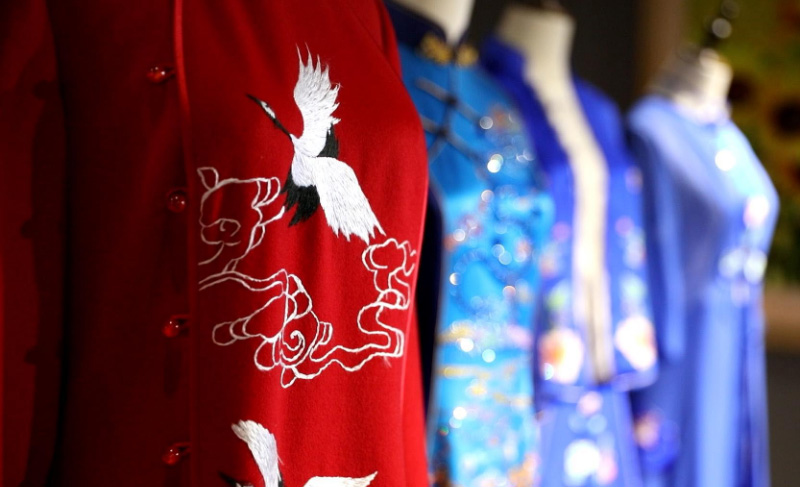

Manchu embroidery has been around for over 1,000 years. Gradually, over time, the needlework and patterns used to create clothing of daily use developed into the beautiful Manchu embroidery that we know today.
Aside from its undeniable beauty, the embroidery style has become a means of escaping poverty for rural residents in Liaoning Province.
Yang Xue is a full-time embroidery craftswoman working in Shenyang, the capital city of northeast China’s Liaoning Province. She earns decent money and can provide for her family, a far cry from her previous life, taking paid labor jobs just to make ends meet in her hometown of Qianjiagou Village.
Women in Qianjiagou, a tiny village of just 260 households, predominantly worked in agriculture, if at all. When she had a child, Yang had to give up work altogether to look after the baby, leaving her husband to deal with the family’s financial burden alone.
One day, however, her friend Wu Nan introduced her to Manchu embroidery, and she never looked back.

“After a period of training, I received my first pay-check, which was over 1,000 yuan for a month's work,” said Yang. “It was a large amount of money for me, with basically no income as a housewife.”
Wu was one of the first villagers to journey to Shenyang to learn Manchu embroidery. By collaborating with Shenyang-based company Shengjing Manchu Embroidery, the village witnessed the first group of female villagers, including Wu herself, move away from the village to train in Shenyang and bring more opportunities back to the village.
Yang Xiaotong, owner of Shengjing Manchu Embroidery, said that Shengjing Manchu embroidery, an imperial symbol from the Qing Dynasty (1644-1911), absorbs the essence of the four most famous Chinese embroidery styles. As an inheritor of this intangible cultural heritage, Yang decided to break the “family only” rule of four generations, hoping that the embroidery skills could become an opportunity for the villagers to earn extra money to pay their bills.
Yang also decided to waive all training fees for her students and offer free accommodation if they were promoted to the Shenyang headquarters, considering most students had trouble making ends meet.
Later, Wu became the leader of the embroidery group in Qianjiagou Village. She recruited seven or eight villagers at first, and that number quickly grew as people realized they could make money without leaving their hometown. Now, over 20 women work here in Qianjiagou, earning a combined income of over 400,000 yuan since August 2018.
Recalling the last couple of years, Wu expressed a sense of pride. “When I first came back with what I had learned from Shenyang, I initiated the program and found a place to set up a workshop from ground zero,” she said.
According to the data provided by the company, from August, 2018 to July, 2019, the company set up 106 poverty alleviation embroidery workshops, helping a total of 1,623 women rise above the poverty line.
“We were pretty confident about the promise of this career back then, especially when we knew that the boss of the company was willing to break the traditional rule and share the technique of Manchu embroidery with us,” said Wu.
Wu told People's Daily Online the story of 49-year-old Hu Jingbo, whose parents are almost 90 years old. Hu has looked after her parents for years, ever since her father was diagnosed with cerebral thrombosis. Hu shouldered the obligation to take care of her parents since her father was diagnosed with cerebral thrombosis years ago.
Joining the workshop ensures her a monthly salary of nearly 2,000 yuan, with the annual per capita income of each embroider in Qian Jiagou Village increasing by 25,000 yuan since the program started last year. The change in income and living standards has had a massive impact on the lives of these women.
“Previously, when the farmland froze in winter, we would sit around playing Mahjong to kill time, but now things have changed,” said Wu. “The embroidery not only cultivates our hobby, but has also changed us, as we can finally do something more meaningful and spirit-lifting.”
“Thanks to the first secretary of our village Party committee, Zhang Yunlu, who started this program, we finally find ourselves occupied with something worth doing, which makes some money at the same time.”
As the first secretary of Qianjiagou Village Party committee, Zhang acted as the coordinator between Shengjing Manchu Embroidery and Qianjiagou Village to initiate this poverty alleviation program.
“My job as a first secretary is to bring change, especially economically, to those impoverished villages under the guidance of China’s rural revitalization strategy, ” Zhang said.
China's rural revitalization strategy is helping revamp the countryside. The strategy was first put forward during the 19th National Congress of the Communist Party of China in 2017 and has been repeatedly stressed by Chinese leadership ever since, aiming for the grand goal of a strong agricultural industry, beautiful countryside and well-off farmers by 2050.
Since the founding of the People’s Republic of China in 1949, more than 800 million Chinese people have risen above the poverty line, representing a 70 percent reduction in global poverty. The year 2020 marks a crucial stage for China's poverty alleviation campaign, and none of this could have happened without people like Zhang Yunlu and Wu Nan, who fully dedicate themselves to the goal of leaving poverty where it should remain - in the past.